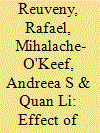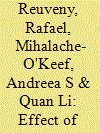|
|
|
Sort Order |
|
|
|
Items / Page
|
|
|
|
|
|
|
| Srl | Item |
| 1 |
ID:
101692


|
|
|
|
|
| Summary/Abstract |
Does warfare affect the environment? This question has received some theoretical and empirical attention, but none of the extant studies has employed large-N statistical models. This article theorizes the possible effects of warfare on the environment and estimates large-N statistical models of these effects on CO2 emissions per capita, NOX emissions per capita, the rate of change in forested area, and a composite indicator of environmental stress reduction. The results indicate that warfare significantly affects the environment, but the signs and sizes of these effects depend on the environmental attribute (whether the fighting is at home or abroad) and development (whether the fighting country is developed or less developed). Warfare reduces CO2 emissions, but the effect is weaker in less developed countries (LDCs) than in developed countries (DCs). Warfare increases deforestation when fought at home and promotes forest growth when fought abroad, particularly in the LDCs. Warfare at home reduces NOX emissions for the LDCs and increases them for the DCs; warfare abroad increases NOX emissions for both the DCs and LDCs. Finally, warfare increases aggregated environmental stress, particularly for the LDCs when fought at home and for the DCs when fought abroad. The sizes of these effects are on par with or larger than the mandated or recommended policy goals stated by the US government for changes in CO 2 and NOX emissions, and by the World Bank (and by implication the DCs driving its policy) for the rate of deforestation, during the coming decade.
|
|
|
|
|
|
|
|
|
|
|
|
|
|
|
|
| 2 |
ID:
101693


|
|
|
|
|
| Publication |
2010.
|
| Summary/Abstract |
Does warfare affect the environment? This question has received some theoretical and empirical attention, but none of the extant studies has employed large-N statistical models. This article theorizes the possible effects of warfare on the environment and estimates large-N statistical models of these effects on CO2 emissions per capita, NOX emissions per capita, the rate of change in forested area, and a composite indicator of environmental stress reduction. The results indicate that warfare significantly affects the environment, but the signs and sizes of these effects depend on the environmental attribute (whether the fighting is at home or abroad) and development (whether the fighting country is developed or less developed). Warfare reduces CO2 emissions, but the effect is weaker in less developed countries (LDCs) than in developed countries (DCs). Warfare increases deforestation when fought at home and promotes forest growth when fought abroad, particularly in the LDCs. Warfare at home reduces NOX emissions for the LDCs and increases them for the DCs; warfare abroad increases NOX emissions for both the DCs and LDCs. Finally, warfare increases aggregated environmental stress, particularly for the LDCs when fought at home and for the DCs when fought abroad. The sizes of these effects are on par with or larger than the mandated or recommended policy goals stated by the US government for changes in CO 2 and NOX emissions, and by the World Bank (and by implication the DCs driving its policy) for the rate of deforestation, during the coming decade.
|
|
|
|
|
|
|
|
|
|
|
|
|
|
|
|
| 3 |
ID:
098408


|
|
|
|
|
| Publication |
2010.
|
| Summary/Abstract |
Large-n studies of conflict have produced a large number of statistically significant results but little accurate guidance in terms of anticipating the onset of conflict. The authors argue that too much attention has been paid to finding statistically significant relationships, while too little attention has been paid to finding variables that improve our ability to predict civil wars. The result can be a distorted view of what matters most to the onset of conflict. Although these models may not be intended to be predictive models, prescriptions based on these models are generally based on statistical significance, and the predictive attributes of the underlying models are generally ignored. These predictions should not be ignored, but rather need to be heuristically evaluated because they may shed light on the veracity of the models. In this study, the authors conduct a side-by-side comparison of the statistical significance and predictive power of the different variables used in two of the most influential models of civil war. The results provide a clear demonstration of how potentially misleading the traditional focus on statistical significance can be. Until out-of-sample heuristics - especially including predictions - are part of the normal evaluative tools in conflict research, we are unlikely to make sufficient theoretical progress beyond broad statements that point to GDP per capita and population as the major causal factors accounting for civil war onset.
|
|
|
|
|
|
|
|
|
|
|
|
|
|
|
|
|
|
|
|
|